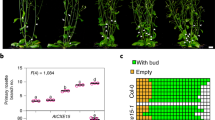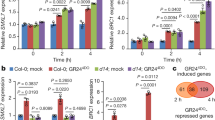Abstract
A carotenoid-derived hormonal signal that inhibits shoot branching in plants has long escaped identification. Strigolactones are compounds thought to be derived from carotenoids and are known to trigger the germination of parasitic plant seeds and stimulate symbiotic fungi. Here we present evidence that carotenoid cleavage dioxygenase 8 shoot branching mutants of pea are strigolactone deficient and that strigolactone application restores the wild-type branching phenotype to ccd8 mutants. Moreover, we show that other branching mutants previously characterized as lacking a response to the branching inhibition signal also lack strigolactone response, and are not deficient in strigolactones. These responses are conserved in Arabidopsis. In agreement with the expected properties of the hormonal signal, exogenous strigolactone can be transported in shoots and act at low concentrations. We suggest that endogenous strigolactones or related compounds inhibit shoot branching in plants. Furthermore, ccd8 mutants demonstrate the diverse effects of strigolactones in shoot branching, mycorrhizal symbiosis and parasitic weed interaction.
This is a preview of subscription content, access via your institution
Access options
Subscribe to this journal
Receive 51 print issues and online access
$199.00 per year
only $3.90 per issue
Buy this article
- Purchase on Springer Link
- Instant access to full article PDF
Prices may be subject to local taxes which are calculated during checkout





Similar content being viewed by others
References
Napoli, C. Highly branched phenotype of the petunia dad1–1 mutant is reversed by grafting. Plant Physiol. 111, 27–37 (1996)
Beveridge, C. A., Symons, G. M., Murfet, I. C., Ross, J. J. & Rameau, C. The rms1 mutant of pea has elevated indole-3-acetic acid levels and reduced root-sap zeatin riboside content but increased branching controlled by graft transmissible signal(s). Plant Physiol. 115, 1251–1258 (1997)
Beveridge, C. A. Axillary bud outgrowth: sending a message. Curr. Opin. Plant Biol. 9, 35–40 (2006)
Foo, E., Turnbull, C. G. & Beveridge, C. A. Long-distance signaling and the control of branching in the rms1 mutant of pea. Plant Physiol. 126, 203–209 (2001)
Morris, S. E., Turnbull, C. G., Murfet, I. C. & Beveridge, C. A. Mutational analysis of branching in pea. Evidence that Rms1 and Rms5 regulate the same novel signal. Plant Physiol. 126, 1205–1213 (2001)
Dodd, I. C., Ferguson, B. J. & Beveridge, C. A. Apical wilting and petiole xylem vessel diameter of the rms2 branching mutant of pea are shoot controlled and independent of a long-distance signal regulating branching. Plant Cell Physiol. 49, 791–800 (2008)
Booker, J. et al. MAX3/CCD7 is a carotenoid cleavage dioxygenase required for the synthesis of a novel plant signaling molecule. Curr. Biol. 14, 1232–1238 (2004)
Auldridge, M. E. et al. Characterization of three members of the Arabidopsis carotenoid cleavage dioxygenase family demonstrates the divergent roles of this multifunctional enzyme family. Plant J. 45, 982–993 (2006)
Bouvier, F., Isner, J. C., Dogbo, O. & Camara, B. Oxidative tailoring of carotenoids: a prospect towards novel functions in plants. Trends Plant Sci. 10, 187–194 (2005)
Sorefan, K. et al. MAX4 and RMS1 are orthologous dioxygenase-like genes that regulate shoot branching in Arabidopsis and pea. Genes Dev. 17, 1469–1474 (2003)
Johnson, X. et al. Branching genes are conserved across species. Genes controlling a novel signal in pea are coregulated by other long-distance signals. Plant Physiol. 142, 1014–1026 (2006)
Schwartz, S. H., Qin, X. & Loewen, M. C. The biochemical characterization of two carotenoid cleavage enzymes from Arabidopsis indicates that a carotenoid-derived compound inhibits lateral branching. J. Biol. Chem. 279, 46940–46945 (2004)
Mouchel, C. F. & Leyser, O. Novel phytohormones involved in long-range signaling. Curr. Opin. Plant Biol. 10, 473–476 (2007)
Doust, A. N. Grass architecture: genetic and environmental control of branching. Curr. Opin. Plant Biol. 10, 21–25 (2007)
Stirnberg, P., van De Sande, K. & Leyser, H. M. MAX1 and MAX2 control shoot lateral branching in Arabidopsis . Development 129, 1131–1141 (2002)
Ishikawa, S. et al. Suppression of tiller bud activity in tillering dwarf mutants of rice. Plant Cell Physiol. 46, 79–86 (2005)
Beveridge, C. A., Ross, J. J. & Murfet, I. C. Branching in pea (action of genes Rms3 and Rms4). Plant Physiol. 110, 859–865 (1996)
Booker, J. et al. MAX1 encodes a cytochrome P450 family member that acts downstream of MAX3/4 to produce a carotenoid-derived branch-inhibiting hormone. Dev. Cell 8, 443–449 (2005)
Cook, C. E. et al. Germination stimulants. 2. The structure of strigol — a potent seed germination stimulant for witchweed (Striga lutea Tour.). J. Am. Chem. Soc. 94, 6198–6199 (1972)
Bouwmeester, H. J., Roux, C., Lopez-Raez, J. A. & Becard, G. Rhizosphere communication of plants, parasitic plants and AM fungi. Trends Plant Sci. 12, 224–230 (2007)
Brachmann, A. & Parniske, M. The most widespread symbiosis on Earth. PLoS Biol. 4, e239 (2006)
Smith, S. E. & Read, D. J. Mycorrhizal Symbiosis (Academic Press, 1997)
Akiyama, K., Matsuzaki, K. & Hayashi, H. Plant sesquiterpenes induce hyphal branching in arbuscular mycorrhizal fungi. Nature 435, 824–827 (2005)
Besserer, A. et al. Strigolactones stimulate arbuscular mycorrhizal fungi by activating mitochondria. PLoS Biol. 4, e226 (2006)
Yoneyama, K., Yoneyama, K., Takeuchi, Y. & Sekimoto, H. Phosphorus deficiency in red clover promotes exudation of orobanchol, the signal for mycorrhizal symbionts and germination stimulant for root parasites. Planta 225, 1031–1038 (2007)
Yoneyama, K. et al. Nitrogen deficiency as well as phosphorus deficiency in sorghum promotes the production and exudation of 5-deoxystrigol, the host recognition signal for arbuscular mycorrhizal fungi and root parasites. Planta 227, 125–132 (2007)
Goldwasser, Y., Yoneyama, K., Xie, X. & Yoneyama, K. Production of strigolactones by Arabidopsis thaliana responsible for Orobanche aegyptiaca seed germination. Plant Growth Regul. 55, 21–28 (2008)
Matusova, R. et al. The strigolactone germination stimulants of the plant-parasitic Striga and Orobanche spp. are derived from the carotenoid pathway. Plant Physiol. 139, 920–934 (2005)
Xie, X. et al. 2'-epi-orobanchol and solanacol, two unique strigolactones, germination stimulants for root parasitic weeds, produced by tobacco. J. Agric. Food Chem. 55, 8067–8072 (2007)
Xie, X. et al. Isolation and identification of alectrol as (+)-orobanchyl acetate, a germination stimulant for root parasitic plants. Phytochemistry 69, 427–431 (2008)
Yoneyama, K. et al. Strigolactones, host recognition signals for root parasitic plants and arbuscular mycorrhizal fungi, from Fabaceae plants. New Phytol. 179, 484–494 (2008)
Stirnberg, P., Furner, I. J. & Leyser, H. M. O. MAX2 participates in an SCF complex which acts locally at the node to suppress shoot branching. Plant J. 50, 80–94 (2007)
Li, C. J. & Bangerth, F. Autoinhibition of indoleacetic acid transport in the shoots of two-branched pea (Pisum sativum) plants and its relationship to correlative dominance. Physiol. Plant. 106, 415–420 (1999)
Turnbull, C. G., Booker, J. P. & Leyser, H. M. Micrografting techniques for testing long-distance signalling in Arabidopsis . Plant J. 32, 255–262 (2002)
Cowling, R. J., Kamiya, Y., Seto, H. & Harberd, N. P. Gibberellin dose-response regulation of GA4 gene transcript levels in Arabidopsis . Plant Physiol. 117, 1195–1203 (1998)
Booker, J., Chatfield, S. & Leyser, O. Auxin acts in xylem-associated or medullary cells to mediate apical dominance. Plant Cell 15, 495–507 (2003)
Nemhauser, J. L., Mockler, T. C. & Chory, J. Interdependency of brassinosteroid and auxin signaling in Arabidopsis . PLoS Biol. 2, e258 (2004)
Foo, E. et al. The branching gene RAMOSUS1 mediates interactions among two novel signals and auxin in pea. Plant Cell 17, 464–474 (2005)
Remy, W., Taylor, T. N., Hass, H. & Kerp, H. Four hundred-million-year-old vesicular arbuscular mycorrhizae. Proc. Natl Acad. Sci. USA 91, 11841–11843 (1994)
Kenrick, P. & Crane, P. R. The origin and early evolution of plants on land. Nature 389, 33–39 (1997)
Lopez-Raez, J. A. et al. Tomato strigolactones are derived from carotenoids and their biosynthesis is promoted by phosphate starvation. New Phytol. 178, 863–874 (2008)
Strader, L. C. & Bartel, B. A new path to auxin. Nature Chem. Biol. 4, 337–339 (2008)
Miyawaki, K. et al. Roles of Arabidopsis ATP/ADP isopentenyltransferases and tRNA isopentenyltransferases in cytokinin biosynthesis. Proc. Natl Acad. Sci. USA 103, 16598–16603 (2006)
Berleth, T., Krogan, N. T. & Scarpella, E. Auxin signals-turning genes on and turning cells around. Curr. Opin. Plant Biol. 7, 553–563 (2004)
Beveridge, C. A., Symons, G. M. & Turnbull, C. G. N. Auxin inhibition of decapitation-induced branching is dependent on graft-transmissible signals regulated by genes Rms1 and Rms2 . Plant Physiol. 123, 689–697 (2000)
Dun, E. A., Ferguson, B. J. & Beveridge, C. A. Apical dominance and shoot branching. Divergent opinions or divergent mechanisms? Plant Physiol. 142, 812–819 (2006)
Hewitt, E. J. Sand and Water Culture: Methods Used in the Study of Plant Nutrition 2nd edn (London and Reading: Commonwealth Agricultural Bureau, The Eastern Press, 1966)
Giovannetti, M. & Mosse, B. An evaluation of techniques for measuring vesicular-arbuscular infection in roots. New Phytol. 84, 489–500 (1980)
Vierheilig, H., Coughlan, A. P., Wyss, U. & Piche, Y. Ink and vinegar, a simple staining technique for arbuscular-mycorrhizal fungi. Appl. Environ. Microbiol. 64, 5004–5007 (1998)
Arumingtyas, E. L., Floyd, R. S., Gregory, M. J. & Murfet, I. C. Branching in Pisum: inheritance and allelism tests with 17 ramosus mutants. Pisum Genet. 24, 17–31 (1992)
Symons, G. M. & Murfet, I. C. Inheritance and allelism tests on six further branching mutants in pea. Pisum Genet. 29, 1–6 (1997)
Acknowledgements
V.G.-R. was supported by the French Ministry of Research and Higher Education. S.F. was supported by a grant from ANR. H. B. and R. M. were supported by a grant from The Netherlands Organisation for Scientific Research (NWO; VICI-grant). The authors are grateful to A. Marion-Poll for discussions, H. M. O. Leyser for supply of the Arabidopsis max4 seed, K. Yoneyama for the gift of orobanchyl acetate, and D. M. Joel for providing O. crenata seeds. The UPLC/QTOF mass spectrometer was made available to us by the Institut des Technologies Avancées du Vivant (Toulouse, France). We thank K. Condon for plant husbandry, the ARC Centre of Excellence for Integrative Legume Research and the European Union FP6 Grain Legumes Integrated Project for financial support.
Author information
Authors and Affiliations
Corresponding authors
Supplementary information
Supplementary Information
The file contains Supplementary Figure 1 with Legend. (PDF 122 kb)
Rights and permissions
About this article
Cite this article
Gomez-Roldan, V., Fermas, S., Brewer, P. et al. Strigolactone inhibition of shoot branching. Nature 455, 189–194 (2008). https://doi.org/10.1038/nature07271
Received:
Accepted:
Published:
Issue Date:
DOI: https://doi.org/10.1038/nature07271
This article is cited by
-
Role of soil abiotic processes on phosphorus availability and plant responses with a focus on strigolactones in tomato plants
Plant and Soil (2024)
-
Innovations in functional genomics and molecular breeding of pea: exploring advances and opportunities
aBIOTECH (2024)
-
Genetic and functional mechanisms of yield-related genes in rice
Acta Physiologiae Plantarum (2024)
-
Strigolactone and abscisic acid synthesis and signaling pathways are enhanced in the wheat oligo-tillering mutant ot1
Molecular Breeding (2024)
-
The role of strigolactone analog (GR24) in endogenous hormone metabolism and hormone-related gene expression in tobacco axillary buds
Plant Cell Reports (2024)
Comments
By submitting a comment you agree to abide by our Terms and Community Guidelines. If you find something abusive or that does not comply with our terms or guidelines please flag it as inappropriate.



